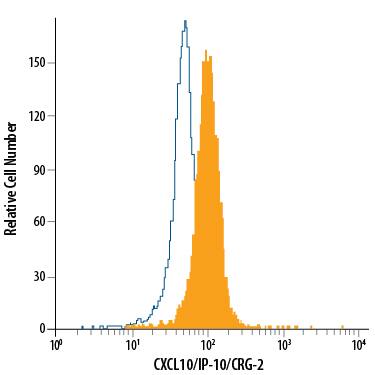Human CXCL10/IP-10/CRG-2 PE-conjugated Antibody
R&D Systems, part of Bio-Techne | Catalog # IC266P


Key Product Details
Species Reactivity
Validated:
Cited:
Applications
Validated:
Cited:
Label
Antibody Source
Product Specifications
Immunogen
Val22-Pro98
Accession # P02778.2
Specificity
Clonality
Host
Isotype
Scientific Data Images for Human CXCL10/IP-10/CRG-2 PE-conjugated Antibody
Detection of CXCL10/IP-10/CRG-2 in Human Blood Monocytes by Flow Cytometry.
Human peripheral blood monocytes treated with LPS were stained with Mouse Anti-Human CXCL10/IP-10/CRG-2 PE-conjugated Monoclonal Antibody (Catalog # IC266P, filled histogram) or isotype control antibody (Catalog # IC002P, open histogram). To facilitate intracellular staining, cells were fixed with Flow Cytometry Fixation Buffer (Catalog # FC004) and permeabilized with Flow Cytometry Permeabilization/Wash Buffer I (Catalog # FC005). View our protocol for Staining Intracellular Molecules.Applications for Human CXCL10/IP-10/CRG-2 PE-conjugated Antibody
Intracellular Staining by Flow Cytometry
Sample: Human peripheral blood monocytes treated with LPS were fixed with Flow Cytometry Fixation Buffer (Catalog # FC004) and permeabilized with Flow Cytometry Permeabilization/Wash Buffer I (Catalog # FC005)
Formulation, Preparation, and Storage
Purification
Formulation
Shipping
Stability & Storage
- 12 months from date of receipt, 2 to 8 °C as supplied.
Background: CXCL10/IP-10/CRG-2
CXCL10 was originally identified as an IFN-gamma -inducible gene in monocytes, fibroblasts and endothelial cells. It has since been shown that CXCL10 mRNA is also induced by LPS, IL-1 beta, TNF-alpha, IL-12, and viruses. Additional cell types that have been shown to express CXCL10 include activated T-lymphocytes, splenocytes, keratinocytes, osteoblasts, astrocytes, and smooth muscle cells. CXCL10 is also expressed in psoriatic and lepromatous lesions of skin. The mouse homologue of human CXCL10, CRG-2, has been cloned and shown to share approximately 67% amino acid sequence identity with human CXCL10. Human CXCL10 cDNA encodes a 98 amino acid (aa) residue precursor protein with a 21 aa residue signal peptide that is cleaved to form the 77 aa residue secreted protein. The amino acid sequence of CXCL10 identified the protein as a member of the chemokine alpha subfamily that lacks the ELR domain. CXCL10 has been shown to be a chemoattractant for activated T-lymphocytes. CXCL10 has been reported to be a potent inhibitor of angiogenesis and to display a potent thymus-dependent antitumor effect. A chemokine receptor specific for CXCL10 and Mig has been cloned and shown to be highly expressed in IL-2-activated T-lymphocytes.
References
- Loetscher, M. et al. (1996) J. Exp. Med. 184:963.
- Wang, X. et al. (1996) J. Biol. Chem. 271:24286.
Alternate Names
Gene Symbol
UniProt
Additional CXCL10/IP-10/CRG-2 Products
Product Documents for Human CXCL10/IP-10/CRG-2 PE-conjugated Antibody
Product Specific Notices for Human CXCL10/IP-10/CRG-2 PE-conjugated Antibody
For research use only